
At Infotex, we’re known for the strength of our websites… but physical strength? Not so much…
It’ll come as no surprise, then, that our team training for the Whole Hog in October, in aid of Home-Start, is proving a bit of a shock to the system. Luckily, Luke at Airborne Fit has kindly stepped in to help our team get fit for the big day.

With our bodies usually glued to the desk chairs, the three of us were rather apprehensive when we turned up at the Airborne group workout session. The feel good factor and friendly faces soon lifted out spirits as we began what promised to be a real test of endurance. Starting with 5,10,15,20,25 repetitions of exercises – squats, press-ups, star jumps, sit-ups, planks – before ending in a jog and a plank until the 2 minute timer was up. Then rest… We wish! Same again, this time trying to better our times whilst keeping a good form.
At this point we were struggling, yet the worst was still to come. We had 1 minute to do as many repetitions of an exercise as possible before a 30 second break followed by another minute of an exercise, and so on… Around 6 rounds later, the circuit ended on a (roughly) 200 meter run to and from a distant tree. We were completely defeated, and our minds were very much set on a cold shower and bed, but more was to follow as just a few moments later we had to gear ourselves up for the same again. This time trying to improve the amount of reps we did before, which we can honestly say proved impossible.
However, once we dragged ourselves over the finish line and warmed down, there was a sense of accomplishment in the air amongst the group which certainly carried over the next few days (that, along with our very tired and achy bodies). It’s that feeling which gives us no doubt we’ll go again! Just as long as we have 3 free days post workout to recover!

As you can imagine the team is feeling slightly daunted at this point by how much training there still is to go, but grateful to have Airborne Fit on our side!
If you’re struggling to picture the mud, sweat, water and obstacle extravaganza that is the Whole Hog, you can watch of a video of the race in action… and you might be enlightened as to why we’re putting ourselves through, what seems to us, such vigorous training.

Hearing about the work done by Home-Start has made a huge impression on everyone here at Infotex, so the team motivation remains high with our goal in mind. We know that giving a significant donation this autumn can make a huge difference to the lives of thousands.
Please visit our JustGiving page if you would like to donate: www.justgiving.com/fundraising/infotex
Children miss out on the most important years of their life because of family crisis. Home-Start helps families who are reaching breaking point because of isolation, bereavement, illness, poverty, and more.
The winter of 2021 is going to be another particularly tough one for countless families across the country who are lacking the support they need post-pandemic. Home-Start works toward creating more stable, loving, and fun childhoods by working with parents and children together, by spending time at home with families, giving children what they need for their first day at school, helping families access the services they need, supporting young mothers, and creating groups for parents to get together and talk, and much more. They take an approach that is individual, expert, confidential, and compassionate.
The difficulties of isolation, the effects of postnatal illness, disability or mental health issues, bereavement, multiple births, and poverty or financial difficulties are just some of the challenges faced by families in the UK. No matter who you are, a difficult life-changing event can happen to anyone.
For more about Home-Start checkout their website www.home-start.org.uk

Thank you so much for taking the time to read this, and if you can, please visit our JustGiving page to donate: www.justgiving.com/fundraising/infotex
The year is 1991, Operation Desert Storm is in full swing in Iraq, the Soviet Union is being dissolved, the Channel Tunnel has yet to open, and Tim Berners-Lee announces the World Wide Web project.
Against this background a computer science student studying at the University of Helsinki, Finland, called Linus Benedict Torvalds posts to a NNTP usergroup (a precursor to web forums) on 25th August 1991:
“Hello everybody out there using minix –
I’m doing a (free) operating system (just a hobby, won’t be big and professional like gnu) for 386(486) AT clones. This has been brewing since april, and is starting to get ready. I’d like any feedback on things people like/dislike in minix, as my OS resembles it somewhat (same physical layout of the file-system (due to practical reasons) among other things).
I’ve currently ported bash(1.08) and gcc(1.40), and things seem to work. This implies that I’ll get something practical within a few months, and I’d like to know what features most people would want. Any suggestions are welcome, but I won’t promise I’ll implement them 🙂
Linus (torvalds@kruuna.helsinki.fi)
PS. Yes – it’s free of any minix code, and it has a multi-threaded fs. It is NOT portable (uses 386 task switching etc), and it probably never will support anything other than AT-harddisks, as that’s all I have :-(.”
His new Operating System was initially only permitted for use on hobby machines with restrictions against use in commercial environments.

Oh, how the world has changed beyond Linus’s wildest dreams!
Fortunately in the last 30 years, Iraq has returned to a relative peace, the Channel Tunnel has come to take around 1/3rd of the passengers travelling from Dover to France, the World Wide Web project can be considered a success with around 2 billion sites now online, and Linus has relented to allow commercial activity based on his operating system!
His “hobby” operating system has now become “big and professional” itself, powering the majority of websites in use in 2021.
In 1996 Linus Torvalds proposed a contest to design a logo for this new operating system, which he suggested resemble a penguin “stuffed to its brim with herring”. Thus a black, white and yellow penguin designed by Larry Ewing came to symbolize the operating system and was subsequently named Tux (purportedly standing for Torvalds Uni-X).

Linux is open-source software meaning that anyone can download the entire source code from www.kernel.org and anyone who has created an account can propose amendments to the operating system, which is one reason it has been so successful.
The size of the code has increased significantly over time, from the mere 7,400 lines of ‘C’ code in version 0.11 to around 17 million lines of code in the current version, yet the structure of the two codebases is very similar. All the additional code is there to incorporate features such as native containerisation, virtualisation support, and the ability to run on an amazingly wide range of hardware.
Linus himself still plays a major role in the direction that Linux takes. Given the size of the project and the number of contributors, there are several managers who oversee specific areas of development, but anything outside of that requires Linus’s approval, even today.
Where Linux differs from its competitors such as Microsoft Windows is that it requires such low levels of system resource (CPU / memory etc.) so it can run in a wide variety of systems – including TV’s, car dashboards, even household fridges! It is also more stable than most other alternatives, with servers rarely needing a restart except for the installation of security updates – try running Windows 10 for a year without rebooting!
Infotex has been running various versions of Linux on the majority of our web servers for more than 20 years, and some of our staff use it on their desktop computer as well.
We’ll be raising a glass to Linux on the 25th August to celebrate Tux reaching its 30th birthday, and we look forward to celebrating many more years to come. Few would have guessed where Linus’s little hobby from 30 years ago would be today and it’s hard to imagine what the world, especially computing, will be like in another 30 years time!
Amongst recent trends in brand development, logo redesign seems to be making the biggest mark… Burger King, Pfizer, Warner Bros, Cadbury’s, and BMW are just a handful of the big names who’ve opted for a refresh in the last year.

A logo is at the heart of a brand identity – it communicates the values and quality of a product or service, but most importantly, it allows customers to build a strong association with your brand. The popular move now is to upgrade to simplified, flat-design logos that work across many platforms.
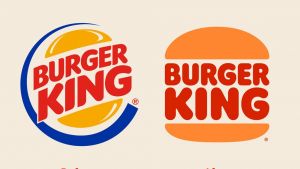
Some companies, of course, never need to change their logos too drastically (think Nike and Spotify). But for others, there’s pressure to keep modernising your logo to freshen your brand.
What does your logo say about your company? Is it suitable across multiple technologies? And when might it need a refresh?

Online criticism of the minimalist logo trend, however, is enough to make us think carefully before changing our brand identities too drastically for no reason.
Still, we’ve put together some thoughts about when you might consider that logo facelift, and how to ensure it’s one that continues to accurately communicate your motives and values in an expressive way.
The tendency toward simplification in the evolution of logos is somewhat inevitable. Minimal logo designs are generally easier to digest, and the quicker a logo can get into the mind of a consumer and stay there, the better. They are easily recognizable and memorable, approachable, and highly user-friendly.
Simple, flat logos continue to be hugely effective in translating brand identity to audiences across a range of physical and digital media. What’s more, as some brands become such a prevalent part of our lives, even assimilating into our grammar (to google, to uber), their logos don’t need to hold as much information – we already know the brand promise.
There is a risk when changing a logo, though, that the association people have with your brand might be damaged. Mastercard had to undertake two years of social research before changing to a wordless logo, to ensure people would still recognise it.

There has been backlash to what’s been termed “oversimplification” amongst the logo redesign trend, with a sense that the minimalist, digital-friendly logos we’re seeing are too basic and lose character.

One YouTube trend took off under the title, “Please, don’t turn me into an oversimplified logo!” in response to redesigns like that of Pringles.
Early this year, Firefox minimalist logo memes spread widely, with great sadness that “they killed the fox”, after Firefox introduced what in fact turned out to be a parent brand logo. The fox is very much still alive on the browser icon.

We’ve established why it might not be the best idea to go for a logo refresh for no particular reason, because you’re at risk of losing the essence of your brand. However, there are times it is necessary to think about an update… we suggest taking these key points into consideration…
Your logo no longer just needs to look good in a storefront or brochure. It needs to be as clear and impressionable on a small phone screen as it does on a billboard. Many companies are opting for flat, colourful designs to work across all platforms.

Has your target audience changed? If so, you might need to change too. Instagram’s successful logo upgrade from the previous camera icon came about because, as their head of design Ian Spalter said, it “was beginning to feel…not reflective of the community.” Keeping your logo up to date shows you are listening to your audience.
When something’s broken… fix it.
Sometimes a logo just isn’t cutting it. Two years ago, Slack announced that their original logo proved “absolutely awful”, because, consisting of 11 different colours, it was near impossible to place on top of colourful backgrounds. Their new one keeps the same core spirit of the original, but is more practically refined.
Whether it’s a merger, acquisition, or simple repositioning of brand motives, your logo should grow and change as your brand does.
In 2008, Infotex merged with Shelton Internet, traders with a focus on back end technical development. We wanted to represent who we were as a new team, and the excellent technical capabilities that came with it, so we weaved the characteristic capital letters of the old Shelton Internet logo into our old “infotex” logo and brand name.



At Infotex we’re always on the look out for those important moments when a brand refresh might be necessary. In fact, keep your eyes peeled for some upcoming changes to our brand look…
We are always seeing exciting new trends explode in the design world. Perhaps it won’t be long before flat design logos give way to designs using neumorphism and glassmorhpism.
Whatever happens, you only have to look at, say, Apple, or Instagram, to know that good logo redesign can work wonders. But make sure you’re budding for that refresh for the right reasons.
Receiving prompt and secure payment for orders placed via your website is absolutely vital to any e-commerce system, but selecting and setting up the right payment gateway can often be hurried low on the agenda when setting up a new site.
The payment gateway sits as a middleman between your customer’s bank and your bank. During this process the credit or debit card is validated, checks made to ensure funds are available, anti-fraud analysis run, and then (eventually) funds are transferred to your bank.

To take payments online you will probably need an internet merchant account (IMA). Some gateways are an all-in-one solution and don’t require an IMA, such as Stripe. An Internet Merchant Account is different from your business bank account, you can’t pay in or withdraw from it – it’s just an intermediary account. The IMA enables you to start accepting online payments when used in conjunction with a payment gateway.
Internet Merchant Accounts can be obtained via your existing bank, or from some payment service providers (PSPs). The bank or the PSP will assess the risk of the business trading online, and for new companies, without a banking history, this can be a drawn-out process.
For taking payments a customer can either remain on your website to enter their card details (onsite transaction) or be taken to the gateway’s website to pay (offsite transaction). The former has an increased process for PCI compliance (see below).
Within these, there is a subset of gateways, such as Apple Pay, Google Pay and PayPal, where a user has a payment method (either a card or bank details) and contact information stored in their account with the gateway. This means a customer only needs to authenticate the transaction, such as logging in or using a or login to pay. Having these on your site can increase the conversion rate.
Sadly, as with any financial transaction, taking payments online carries a risk of fraud. All payment providers will have a level of anti-fraud technology, screening cards and customer information and grading the results. Some systems will auto-block transactions with a high risk, others will flag them so you can make a decision. There is a careful balance to find between preventing fraud and not making it difficult for real customers to pay.
3D Secure transactions, where a customer is prompted to enter a password/code to complete the transaction, are covered by a liability shift. Should a 3D Secure transaction be claimed as fraudulent, the onus moves from you to the card issuer.

Payment Card Industry Data Security Standard is a set of worldwide requirements which aim to protect cardholder information from theft and fraud. If you take any sort of credit/debit card data (including card machines) you must comply with the standards and take steps to prove you have done so to your bank. This is usually done via a Qualified Security Assessor (QSA), companies that will be helping you perform PCI compliance assessments. Failure to be PCI compliant can result in fines from your bank and the loss of the ability to take card payments.
If you use an offsite payment method then you should be able to complete a yearly Self Assessment Questionnaire (SAQ) to achieve compliance. If you take onsite payments this will involve a much more detailed questionnaire and a regular vulnerability security scan of your website and network. Using a virtual terminal (see below) will also increase your PCI requirements as you are directly handling customer’s card data.
For more information on PCI DSS please visit https://www.pcisecuritystandards.org/
Selecting a gateway shouldn’t just be about transaction fees – also check what additional services and features are available.
Virtual Terminals
A virtual terminal allows you to process card payments over the phone or via their written instructions, typing their details into your computer. You will need to see if you require a Mail Order Telephone Order (MOTO) merchant account to take advantage of a virtual terminal. Note that virtual terminals will affect the requirements of your PCI compliance.
Reporting
Reconciliation of accounts is also vital to any business, so having clear and accurate information on tap in a useful format is a huge benefit.
Invoicing & Link Payments
Some providers allow you to issue invoices directly from their platform to your customers. The invoices contain a link to pay directly online via card, so often get paid much quicker than traditional paper invoicing.
If you’re not after full invoicing, some platforms have the ability to send a simple link to a customer via email, which takes them to a payment page to enter card information.
Integrations
Maybe they offer direct integration to your accounts software or add-ons that allow for recurring payments, but check out add-ons or plugins that extend the functionality of the gateway. Also be aware of future requirements you may have, such as taking payments in other currencies and check that your chosen gateway can do those.

PayPal always comes up in discussions about online payments, being one of the most popular ways to receive online payments and very easy to set up. A common misconception is that customers need a PayPal account in order to pay, however, customers can use their credit or debit cards directly. Unfortunately, this isn’t always made clear to customers as they checkout which puts off a lot of merchants from using it as their sole gateway.
A big positive for existing PayPal customers is they have your details saved – both contact and card information. This means that the customer saves time by simply logging in to their account and accepting the transaction amount they have paid, instead of filling in forms and finding a payment card. Just having the PayPal logo on your site can encourage customers to pick your store.
PayPal has a range of ways to receive payments online, the most basic of which is PayPal buttons. These are super basic Buy Now or Pay with PayPal buttons that you can add to your site with a little bit of code. Customers can then click on them, be taken to PayPal, and then either login and pay by their existing PayPal account, or via credit or debit card.
As a step up from that is PayPal Checkout. This integrates with your ecommerce store so customers can have a basket full of items to checkout with, again being taken to PayPal to complete their purchase.
PayPal has also recently added PayPal Credit, where customers can buy now and pay later, with 0% interest on orders over £99. Customers are pre-approved, and obviously terms and conditions apply. This is all handled on PayPal’s side, so from a merchant point of view doesn’t require you to do anything.
PayPal isn’t always the most popular with merchants though, with higher than average transaction fees if you’re a low volume merchant, and there have been reports of accounts being suspended with little to no notice.

Previously known as Sage Pay, Opayo is a very popular payment gateway. This is more of a traditional gateway, where the customer is asked to enter their payment details – so no quick checkout with saved cards as with PayPal.
Opayo has a range of site integration methods, both on and off-site, and can accept deferred and recurring payments. They have a few pricing plans, with the most basic starting at £25p/m for 350 transactions.

Stripe may not be a name familiar to everyone, but it’s used on thousands of sites, including deliveroo, Waitrose, and booking.com. They have competitive transaction fees with no setup or monthly costs. It is easily integrated into WooCommerce and allows you to take Apple Pay and Google Pay as well. The admin area is a little busy and takes a while to learn.

Another of the big names in online payments, Worldpay offer an onsite or offsite payment gateway integration. Prices start at £19 per month, and minimum contract applies. Outside of that their fee structure is opaque and requires you to contact them. They also offer physical card terminals, for those of you doing face to face payments.

Like PayPal, Google Pay and Apple Pay are hugely powerful logos to have on your site. People know they will be able to checkout quickly, as their payment and delivery details are already saved on their device. Usually, you would have other payment options alongside Google Pay and Apple Pay, for people to purchase with a debit or credit card. Integration is also usually done via another payment gateway, for example if you use Stripe and WooCommerce you can enable them without having to register for separate accounts.
Not strictly a payment gateway, GoCardless allows you to take recurring payments directly from your customer’s bank accounts. GoCardless are effectively a modern take on Direct Debits, which is the basis of their system is built upon.

Klarna allows customers to split their payments across multiple interest-free instalments. Klarna pays the merchant for the product as soon as the customer completes their purchase. Again, it’s another option that isn’t clear on their transaction fees, but it’s somewhere around 2.49%+20p per transaction. This option can be popular with customers, but there are grumblings about being refused payment options and charges being taken when goods had been returned.

WooCommerce Payments is built on the backbone of Stripe, with identical fee structure, it provides an integrated interface directly into your WooCommerce store admin area for managing payments. Customers can pay directly in your website without leaving to go to a separate gateway site, and save their card details for faster payments in the future.
It’s always best to speak to your web development agency before engaging with any payment gateway, as they will have experience with a wide range of them and can help you navigate the pitfalls. They will also be familiar with what gateways your ecommerce site can work with, as some platforms are harder to integrate than others and while you may save a few pounds on your transaction fees the initial integration fees can offset that.
We don’t need a pandemic to remind us that everything starts in the home. The earliest years make the biggest impact on a child’s development, so it’s incredibly important that parents and their children get the support they need when times get hard. Home-Start supports 56,000 children in 27,000 families across the UK in a unique way – by being there for parents, in their time of need.
The difficulties of isolation, the effects of postnatal illness, disability or mental health issues, bereavement, multiple births, and poverty or financial difficulties are just some of the challenges faced by families in the UK. No matter who you are, a difficult life-changing event can happen to anyone.
Home-Start works toward creating more stable, loving, and fun childhoods by working with parents and children together, by spending time at home with families, giving children what they need for their first day at school, helping families access the services they need, supporting young mothers, and creating groups for parents to get together and talk, and much more. They take an approach that is individual, expert, confidential, and compassionate.

Infotex have chosen to take part in fundraising for Home-Start, and in case you can’t guess why we think they’re such a fantastic charity, I asked our MD to explain:
Ant Agar, Infotex’s Managing Director, said “In the lead up to Christmas 2020, we were looking for a good cause relevant to the challenges of COVID19. With the second lockdown pending, we were feeling very aware at Infotex how lucky we had been throughout the pandemic so far. Times had been difficult, of course, but we felt blessed to already be working online as we do, and to be able to keep working.
A friend told me about Home-Start, so I started reading about them. I was immediately impressed by the impact they make, so I contacted their Head of Fundraising Anita for a chat. I was taken aback by the extraordinarily broad reach of the charity and the support they give. They are doing a lot with very little. Their work fills some gaps where health and social services is not able to reach.
I think the way Home-Start achieves so much with so little reminded me of Infotex. As a small company of 23 people, we know full well how a few thousand pounds extra in a year can make a huge difference to an organisation. So it is within our grasp to make a meaningful contribution. We discussed this as a team, and, as we were not able to have a company Christmas gathering, we could give Home-Start a Christmas donation.
In January, Anita joined us online for one of our daily online company catch-ups. The whole Infotex team was so impressed by what she had to tell us about the work they do. Many were really moved by what they learned, and all agreed we would like to do more. So we decided we would, for the second time in our short history, send an Infotex team to run in the “Whole Hog” in October, a 5-mile obstacle-filled, muddy, exhausting (and supposedly fun) race near Woodbridge, from which we aim to raise Home-Start a bit more cash.

The winter of 2021 is going to be another tough one for countless families across the country who are lacking the support they need post-pandemic. We know that giving a significant donation this autumn can make a difference. So training starts now. I am personally feeling a bit daunted, but having a sense of purpose is a great help to get me out there running. I hope all of our friends will be willing to reward us with generous donations to Home-Start when we reach out to them nearer the time”
We’re going to drop in stories about the Home-Start project in the coming months, but to start you off here is an introduction to one of the Home-Start collaborative programmes, called the LENA programme.
Research has shown that the number of words children hear in their first days, months and years have a huge impact on their development in later life. There is a huge gap in the number of words children hear in the first four years of their life between children from lower and higher-income families.
LENA is a coaching programme for parents of children from birth to three years of age. Trained volunteers support families in their own homes to increase their communication and interaction with their child to ensure they get the best start in life. A structured programme over 12 weekly visits is supported by the use of ground-breaking technology developed by the LENA Foundation, which gives families personalised data on how many words a child is hearing and how many conversations they are engaged in. This information allows parents to work with their volunteer to be aware of how they are engaging with their children, and look for ways of increasing the number of words their child hears.
You can find out more about this programme, and hear other stories told directly from those who have been helped by Home-Start, through the Home-Start podcast series!
To give your much-needed support, please visit our JustGiving page.
One of the things our team loves most about our work is the range of clients we get to work with, and the amazing things they do. Here we offer a peek into 6 new projects we have launched last month. From keeping clean to product rentals, they’re businesses that, as always, we’re proud to work with.

Nobody needs to splash out on expensive appliances anymore… Snelling’s brand new website allows customers to pick a product to rent, with free delivery, installation, and repairs. It all began when the company was founded by Roy Snelling as a pioneering Television rental service, back in the 1950s.
Featuring in The Lawyer magazine’s prestigious Top 200 law firm rankings, Stevens Scown is the UK’s first large employee-owned law firm.
The website refresh for Stephens Scown law firm involved the development of the website’s Info Hub, which pulls together their extensive blog content and displays it nicely broken down by video, trending articles and FAQs with a much improved user experience. This was an exciting step forward, particularly after the success of their blog during the lockdown last year (Read more in our blog: website lockdown successes and what we can learn from them).
LAC cleaning is a family run business with over 47 years experience in high standard cleaning services. Their superb cleanliness is evermore appreciated in our current context, you can imagine… and they required a suitably clean and clear website redesign to provide a look and feel that is polished to perfection.

Packability’s history of selling great value packaging products goes all the way back to 1937, when it was founded as Welsh Boxes – a solid board boxes and stocked paper rolls manufacturer. Since then, the company has gone from strength to strength, merging with the global Tri-Wall family and greatly expanding the range of packaging products from its base in South Wales.
Incognito Group are hospitality specialists, offering a bespoke service that opens doors to the world’s best sporting, social, and cultural events. The website is a ‘designer’ theme build on WordPress that displays their new, refreshed brand look, with Events at the core of the website.
With over 20 years combined experience in selling hospitality, and a network of contacts in sport, music and events, their team puts the spotlight firmly on their clients by understanding and interpreting their hopes and aspirations.

This second project for Snellings was to merge the original Snellings and Gerald Giles websites into one retail website. We had to combine these two brands without confusing customers (many of whom have shopped with Snellings for years) and without losing traction in Google. The site uses Gerald Giles for the primary domain, but with dual branding of the logo. We also have clear messaging for anyone visiting from the previous snellings.co.uk address to ensure they are reassured they’re at the right website.
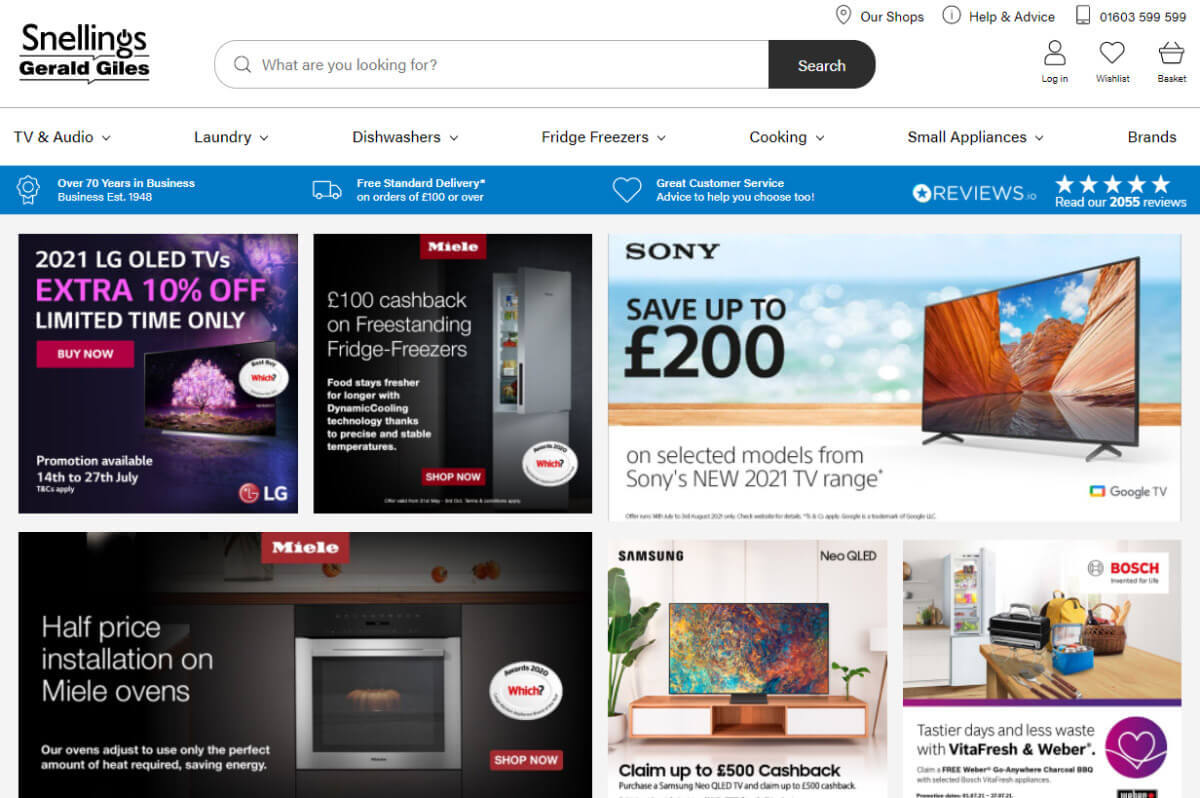
You probably like reading reviews before you purchase a product or service, right? They’re our most trusted source of, well, whether to trust something. Reviews are an essential marketing tool – drawing traffic, creating leads, and making conversions.
People sometimes put off signing up to review sites for fear of receiving negative online reviews, or even none at all. However, you need business reputation to drive traffic, and there are ways to cope with negative online reviews should they arise. Indeed, even negative customer reviews are important because they can help you to see where you might need to improve your customer service.
Maybe you want to be on all the review sites to get the most exposure as possible, or maybe you want to start with just one. Either way, we’ve put together some of the most popular review platforms out there. These cover the biggest B2C and B2B review sites, but of course there are many more out there for particular service and target consumer niches.
Whether you’re business can be found on lots of reviewing platforms or not, don’t forget to include some of those all important testimonials you receive on your own website. If you don’t wish to use a 3rd party like Feefo or Trustpilot then many website platforms such as WordPress or Shopify have their own on-site review systems you can use to get valuable customer feedback automatically.
Business reviews and ratings are now often included in search results. Google, for instance, will often directly display online business reviews and consumer ratings following a search, as shown below.

If you go to your current broadband supplier you will probably be offered one of the following packages:
But not everyone can get even the slowest of these options, depending on where you live.
That hasn’t stopped scientists around the world from vying to develop even faster speeds. In June 2021, a group of researchers in Japan from the National Institute of Information and Communication Technology (NICT) set a new world record of 319 terabits per second (Tb/s) for internet speed. This wasn’t just over a small distance in a lab, it covered over 3000km without any performance drops.
The previous record was 178 terabits per second set in 2020 by engineers at University College London, so this new record was quite a significant increase.
NICT scientists used fibre optics, small tubes that pass information using light. To achieve this record, the team had to use some special add-ons that are only familiar to the very skilled and educated engineers working with lasers.
The engineers said that even regular optical fibre infrastructure could support these types of speeds, but it would need to go through a few modifications first. Regular copper cables couldn’t carry such speeds and would require much more complex infrastructure to work.
Just to put these types of speed in context, in less than a second you could download 57,000 full-length films or download the whole of the Spotify catalogue in under three seconds.
On the 25th June, our Business Development Executive will be undertaking a gruelling four rounds of golf in one day, to raise money for Macmillan Cancer Support.

Tom will be doing this with his dad, brother in law, and family friend (aka The Fore Horsemen), and it will be their first time taking on this 72 hole challenge. To complete it they will walk approximately 20 miles and each take around 350 shots (or more…but who’s counting!).
As a group they have all had personal contact with someone suffering from cancer, and would love to be able to raise some money for this amazing cause that provides the care and support for families and those suffering from cancer.
Tom and his team successfully completed their challenge, and raised over £1,500. If you would like to donate, please visit their donation page at Just Giving.
On building Scarlett & Mustard’s first site some years ago, we always kept in mind that they were going to need an adaptable site that could be updated as the business grew. That time has come, and this month we launched Scarlett & Mustard’s new, modernised website.
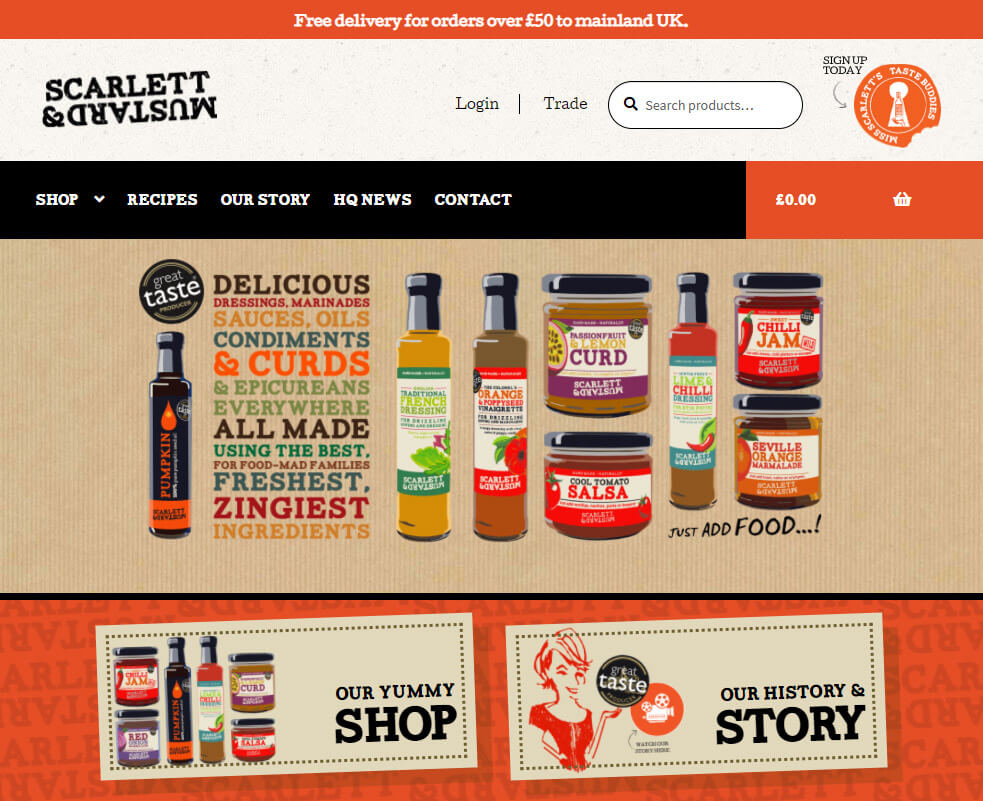
With the Scarlett & Mustard brand at its core, we improved upon existing site functionality and content to give a fresher look to the new website while maintaining consistency of feel.
Some of the new parts to the website include:
“The team have delivered all our objectives on time, within budget and to our complete satisfaction, and we are thrilled with our new website.”
Sandy, Scarlett & Mustard.
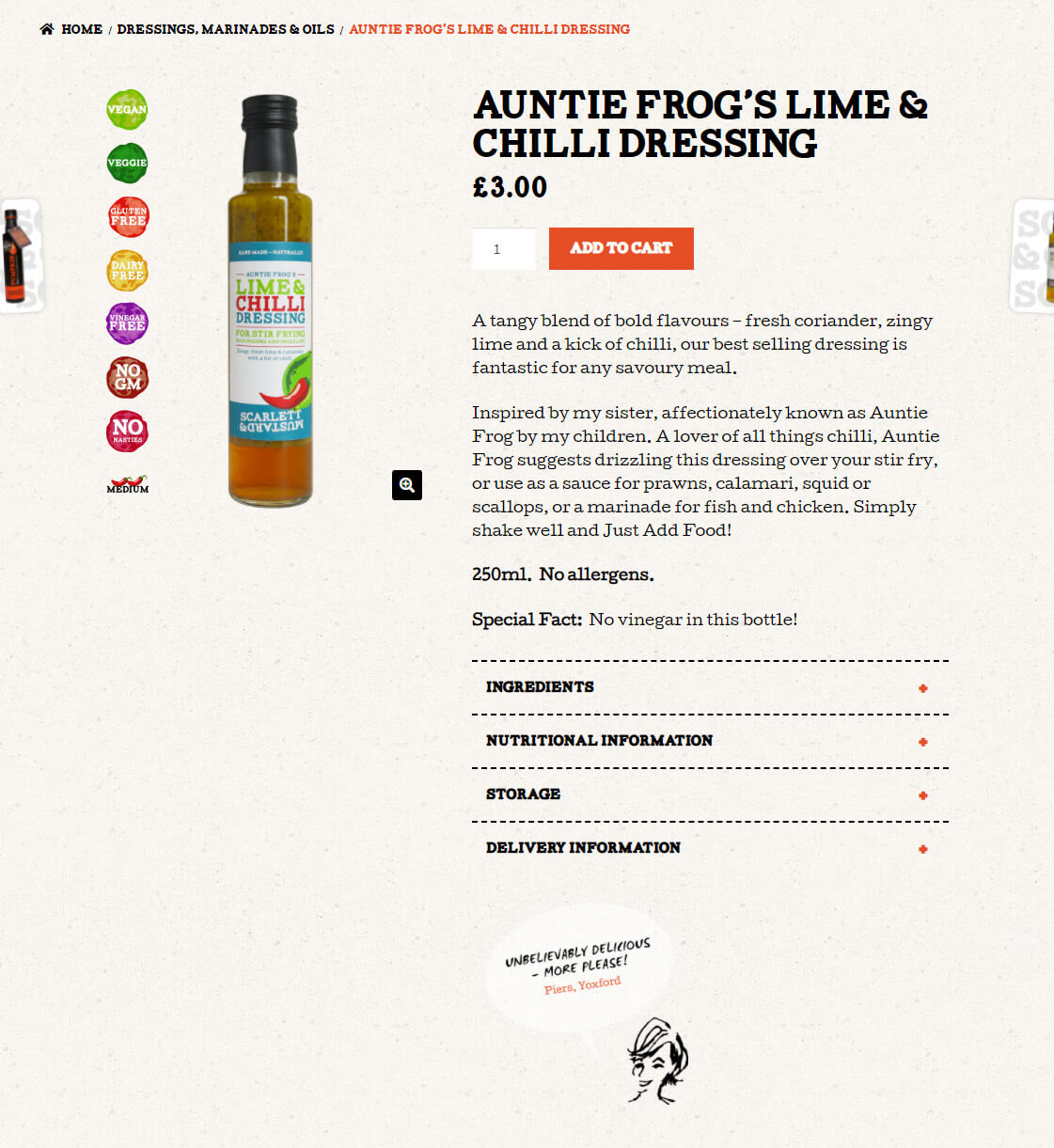
It was a pleasure to complete this new project and see Scarlett & Mustard’s strong sense of brand identity taken to the next level online, where we will continue to support them flourish. We are really excited to move forward with the next phase of marketing the website.
Take a look at the new website and their delicious products at scarlettandmustard.co.uk.

Internet Explorer was first released in August 1995 as a core part of Windows 95. It raised controversy at the time for the fact that it was bundled into Windows, resulting in lawsuits against Microsoft for monopolistic practices. This lead, in no small part, to the downfall of the previously leading browser Netscape Navigator.
Internet Explorer, or IE in tech circles, became the defacto standard and by the early 2000s over 90% of all browsing was being performed via Internet Explorer.

Competitors started to challenge for Internet Explorer’s throne, with potent competitors in the shape of Mozilla Firefox emerging in 2004, and Google releasing the first Chrome in 2008.
Firefox and Chrome took a new approach to browsers, with regular updates adding new features, which developers could leverage to create a more interactive web. IE started to lag with updates being few and far between, generally being bundled into their large Service Packs.
Starting with Windows 10 (and retro-fitted to Windows 7) Microsoft eventually moved their main browser to Microsoft Edge which has subsequently been re-architected to share the rendering engine underpinning Google’s Chrome.
So where did this leave Internet Explorer? Internet Explorer 11, released in 2013, is the last version of the platform and is still installed on the majority of Windows 10 PCs for compatibility purposes, but buried away to encourage people to use Edge. Unlike IE, Edge receives regular updates keeping pace with its main competitors. Currently Edge sees around a 5% market share, far below the lofty heights that previous IE versions once commanded.
Today, Internet Explorer languishes at around 1% market share which is almost entirely within large corporate networks, often running internal systems with lengthy update cycles and / or legacy software.
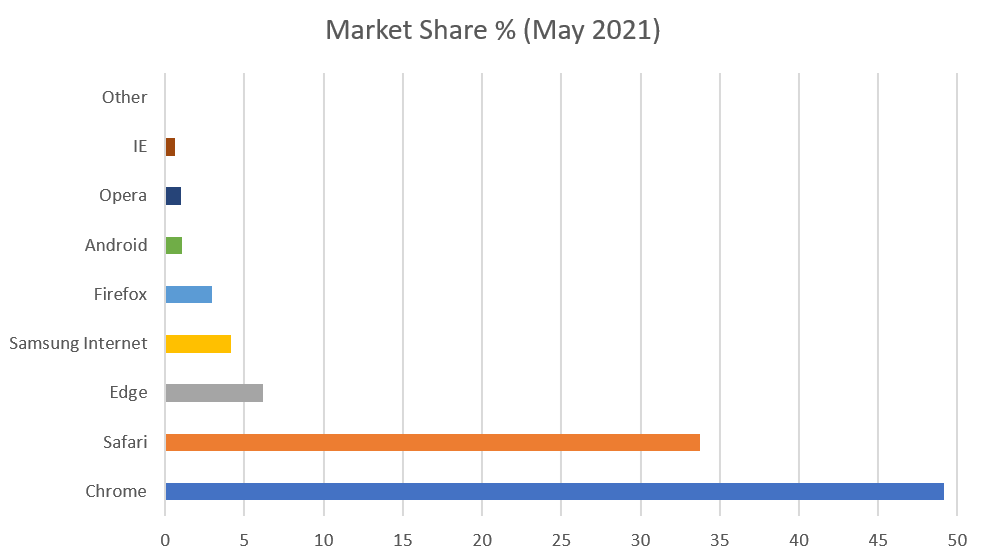
In 2020 Microsoft acknowledged that Internet Explorer has reached the end of the road and that they plan to cease support for it within their Microsoft Office 365 suite with effect from August 2021.
With the release of WordPress 5.8, which is scheduled to occur in July 2021 we will see WordPress, the dominant website Content Management System (CMS), cease support for Internet Explorer 11. As primarily WordPress agency Infotex will be following suit.
By ceasing to support a browser, this means that we will no longer be targeting it during development or testing that your website functions correctly on Internet Explorer. This allows us to focus on browsers that support modern CSS & JavaScript features, offering greater interactivity and performance than was previously possible.
At this time we will not be taking actions to specifically cause your website to be unusable by Internet Explorer so you are unlikely to see any immediate impact. However, unless specifically agreed to the contrary, we will also not be fixing any Internet Explorer specific issues which occur going forward. This means that over time your website may become less usable within Internet Explorer.
WordPress have similarly stated that they will be removing testing for Internet Explorer 11 gradually over versions 5.8 & 5.9 and it is anticipated that the first area that will be impacted will be the content administration areas which utilise modern features to provide the high levels of user experience that site administrators come to expect today. Users on Internet Explorer 11 and earlier may also see a banner within their administration areas advising them to upgrade to a more modern browser.
Goodbye to the friend we all loved to hate and welcome to a more interactive web of the future!
Progressive web apps are essentially web applications that feel and function like a native mobile application. They continue to gain traction due to the positive impact they have on user-experience: advanced capabilities such as offline use and push notifications, and the ability to be “installed” on the user’s device.
PWA’s encompass the best things about a native phone app along with the flexibility and instant nature of the web.

An app, or application, is simply a piece of software designed to serve a purpose. This can range from simple applications such as a calculator through to more complex applications such as word processors.
A native application is one that is designed for a specific device. An application designed for a specific device will often have deep access to that device’s functionality and will be able to maximise performance and integration through the device’s API’s.
Modern applications, such as those within the iOS app store, have to follow strict rules in order for them to be available to download on a user’s device. These rules are intended to improve security, performance, and experience. Apps within these stores are there at the whims of the platform owner and rules are not always obvious nor technically motivated (such as whether to allow a competing payment provider).
Web applications are written for browsers. They utilise various platforms and libraries to provide an experience that can be accessed anywhere. A single website application is able to target desktop, mobile, tablets, tv’s, consoles etc all from a single codebase.
Web applications leverage the inherent power of the internet offering high levels of discoverability and a vast ecosystem of 3rd-party providers, tools, and integrations.
For all of the freedom they provide, web applications require launching a browser and typing an address to access them and they typically do not have access to the same device features as a native application (such as the local file system storing your media, camera, microphone, fingerprint scanner etc).
Progressive web applications are intended to close this gap by offering the advantages of a web application whilst behaving more like a native application on a user’s device (such as the ability to be “installed” and access to more device features).
Progressive web applications leverage a variety of technologies to provide an experience as close to native as possible – so it may be best to think of them as a design/development philosophy. There is no single test to prove that a web application is a PWA although there are tools, such as Google’s lighthouse, that will attempt to score the application based on the presence of certain features.
That said, there are a number of features that exist within PWA’s:
A service worker is a script that intercepts requests and allows for the control of functionality such as caching to allow the web application to function whilst offline and background services.
They offer a lot of potential by responding to, and controlling, data even when the user is not actively using the web application – such as push notifications.
This is a file that describes how the web application appears in the context of the device it is on. For example it dictates the icon displayed when the web application is installed on the device.
The web application must be served over HTTPS in order to have access to features such as service workers.
Many modern websites that you visit are actually using progressive web app technologies to provide an experience closer to that of native applications. You can see this when you visit sites like Twitter, Gmail, etc.
If you want to install them, you can simply utilise your mobile browsers built-in functionality. This varies from browser to browser; On Chrome for Android, for example, PWA’s get an “Install app” link in the browser menu. Whilst any site can be added to your home screen, PWA’s can be installed and will provide you with a more immersive experience when you do this (crucially they will launch in their own window with no browser interface, have a nice icon, colours matching the app, etc).
The functionality available to web applications through browser API’s is improving all the time which means that PWA’s will become more sophisticated and able to offer you parity with your native applications. This means you get all of the benefits of the web whilst still being able to offer a great experience on individual devices.
Discover how our team can help you on your journey.
Talk to us today